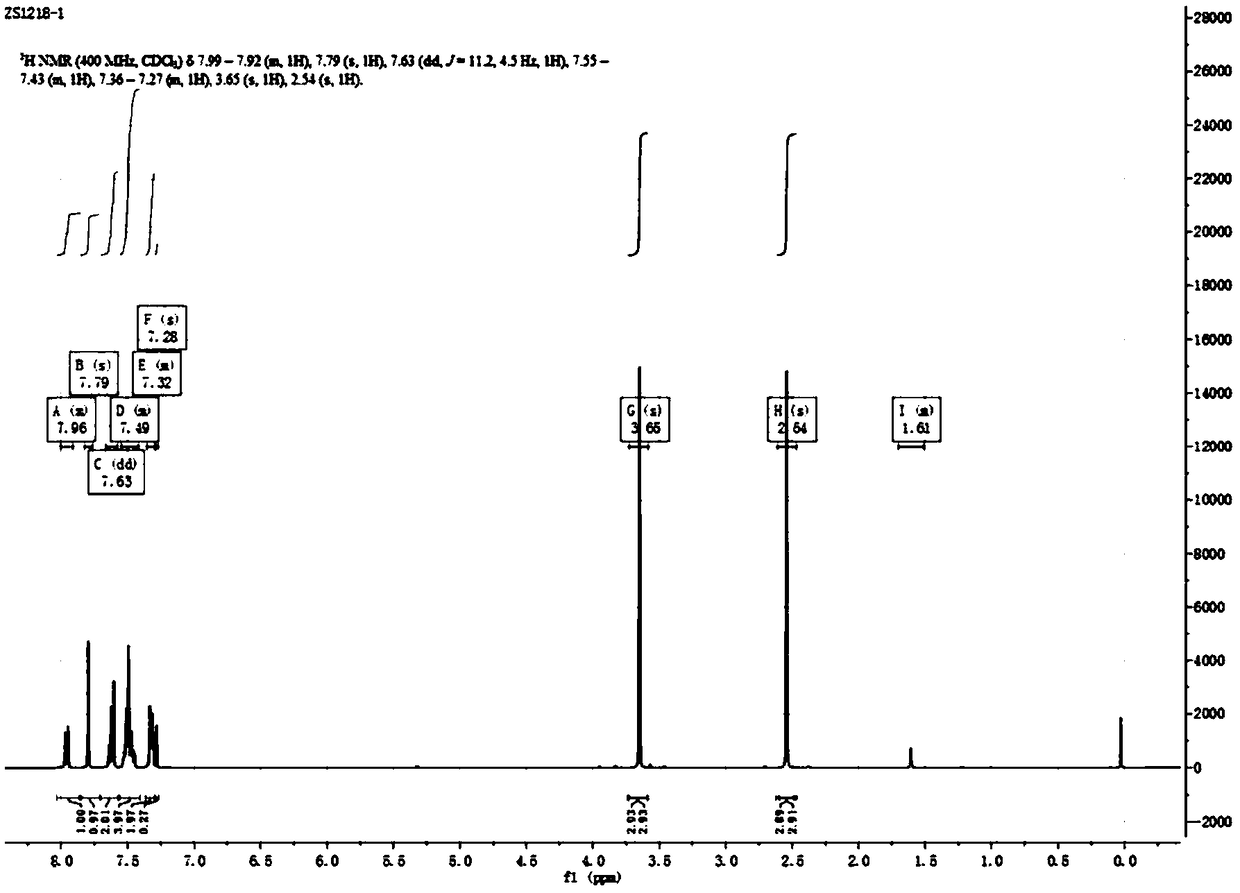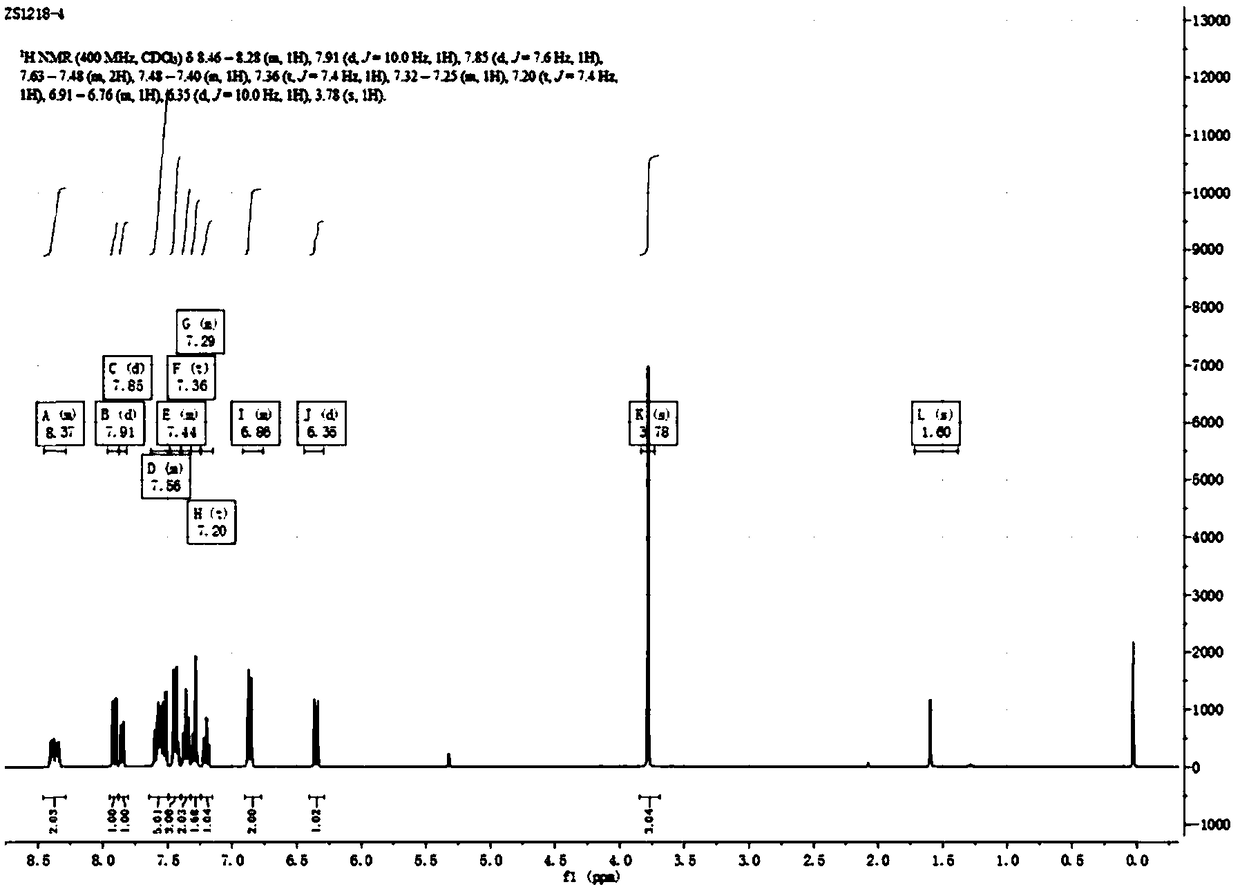Photochromic compound and preparation method thereof
A photochromic and compound technology, applied in chemical instruments and methods, color-changing fluorescent materials, organic chemistry, etc., can solve the problems of uneven dispersion, weak adhesion, low photochromic efficiency, etc., and achieve obvious photochromic phenomenon Effect
- Summary
- Abstract
- Description
- Claims
- Application Information
AI Technical Summary
Problems solved by technology
Method used
Image
Examples
Embodiment 1
[0048] The photochromic compound 3-phenyl-3-(4-methoxyphenyl)-13-methyl-13-methoxy-3,13-dihydrobenzo[h]indene[2,1-f ] Preparation of pyran:
[0049] (1) Preparation of HF-2
[0050]
[0051]In a 10L three-necked flask, add compound HF-1 (300g, 1.14mol), xylene (3000mL) and 800g methanesulfonic acid, heat to 120°C, react for 4h, pour the reaction solution into 500mL water, filter, filter the residue with 100mL water After washing and drying in an air blast oven, 260 g of an earthy gray solid was obtained, with a yield of 92.6%.
[0052] ESI-MS:[M+H] + =247.2
[0053] NMR data: 1 H NMR (400MHz, CDCl 3 )δ7.99–7.92(m,1H),7.79(s,1H),7.63(dd,J=11.2,4.5Hz,1H),7.55–7.43(m,1H),7.36–7.27(m,1H) ,3.65(s,1H),2.54(s,1H).
[0054] (2) Preparation of HF-3
[0055]
[0056] Add HF-2 (246.2g, 1.0mol), 1-(4-methoxyphenyl)-2-propyn-1-ol (333g, 1.4mol), toluene 2.5L, methanesulfonate in sequence to the reaction flask 30g of acid; the reaction temperature is 90-100°C, stirred for 8-1...
Embodiment 2
[0068] Photochromic test of photochromic compounds
[0069] Make the styrene resin monomer of the photochromic compound prepared in Example 1 into a transparent solution, add an appropriate amount of V65, pour it, heat and cure it, and turn it into a colorless and transparent resin lens, and then irradiate it with ultraviolet light for about 2 seconds The solution gradually turns red, and the intensity of the absorption peak increases with the prolongation of the irradiation time, and the coloring depth of the liquid after discoloration gradually becomes darker. After the ultraviolet rays disappeared, the color of the solution faded to colorless rapidly, and the time was about 90s. This illustrates that the photochromic compound has undergone a photochromic reaction under the action of ultraviolet light, and the reaction formula is as follows:
[0070]
[0071] After 10,000 color-changing and fading cycles, there is no significant decline in its color-changing performance....
Embodiment 3
[0073] High temperature test
[0074] Put 10 g of the solid photochromic compound prepared in Example 1 into a crucible, then transfer the crucible to a muffle furnace, raise the temperature to 350° C., and keep the temperature at this temperature for 1 hour. Take out the solid, take 30mg and dissolve it in 100mL styrene resin monomer to make a transparent solution, add an appropriate amount of V65, pour it, heat and cure it, and turn it into a colorless and transparent resin lens, and then irradiate it with ultraviolet light, and the resin lens changes rapidly The red becomes darker, and then the solution is transferred to visible light, and it basically fades to colorless in about 90s. Thus, the compound can withstand high temperatures of 350°C.
PUM
 Login to View More
Login to View More Abstract
Description
Claims
Application Information
 Login to View More
Login to View More - R&D
- Intellectual Property
- Life Sciences
- Materials
- Tech Scout
- Unparalleled Data Quality
- Higher Quality Content
- 60% Fewer Hallucinations
Browse by: Latest US Patents, China's latest patents, Technical Efficacy Thesaurus, Application Domain, Technology Topic, Popular Technical Reports.
© 2025 PatSnap. All rights reserved.Legal|Privacy policy|Modern Slavery Act Transparency Statement|Sitemap|About US| Contact US: help@patsnap.com



